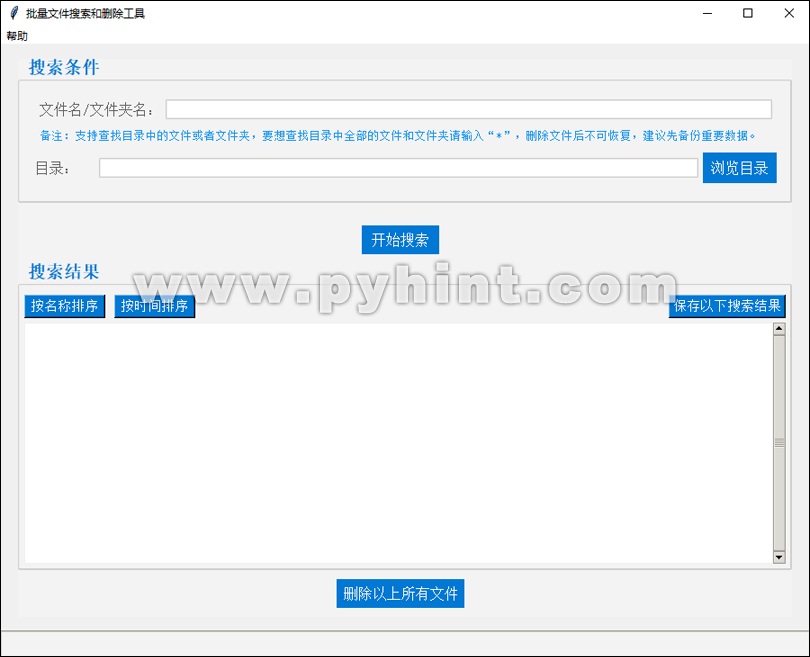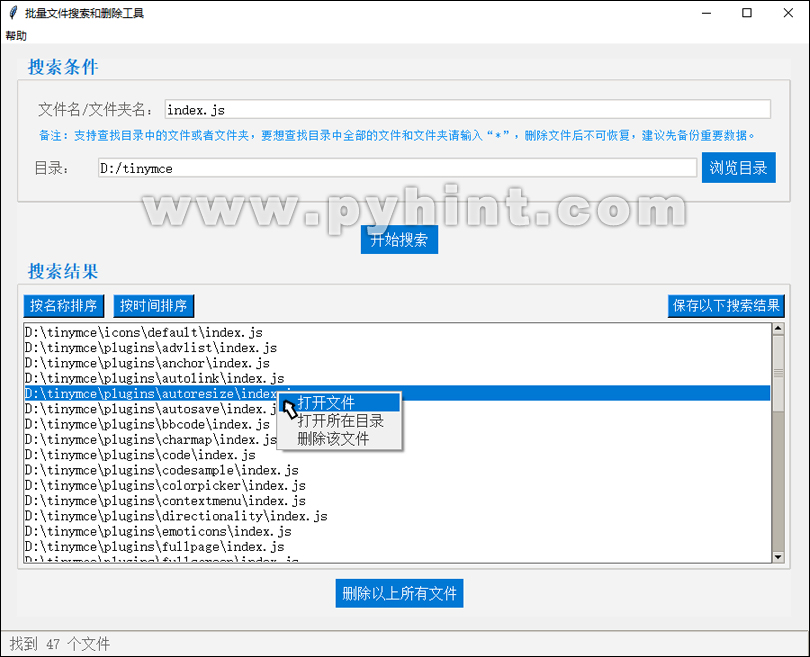在日常工作和生活中,我们经常需要在电脑中查找或删除大量文件,在文件繁杂、种类繁多的情况下,如果通过手动查找或删除文件,可能需要花费数小时,既费时又费力,而通过Python编程可在几秒内完成。
在Python的系统开发或维护中,我们经常需要清理服务器的日志目录或临时文件等,当这些文件数量达到上百个时,手动删除显然不现实。本节教程将介绍如何通过Python安全高效地完成大规模文件搜索和删除任务。
1、批量文件搜索和删除工具介绍
我们的目标是开发一个批量文件搜索和删除工具,结合Python的Tkinter图形用户界面库可以很方便地创建GUI图形界面,以实现批量查找和删除文件的功能。
在指定目录下查找文件或文件夹,主要使用os模块和fnmatch模块。首先,使用os模块的os.walk()方法递归遍历指定目录中所有的目录路径、子目录列表和文件列表,再调用fnmatch模块的fnmatch()方法来检查每个文件的名称是否匹配。fnmatch模块经常用于批量查找文件,通过模式匹配筛选出需要查找的文件名,支持精确、模糊或格式匹配。
功能概述
本程序是基于Python的Tkinter库开发的GUI应用程序,主要功能包括:
-
支持搜索文件或者文件夹,同时支持“*”通配符搜索,输入“*”可以搜索全部的文件和文件夹;输入“*.py”、“*.jpg”、“*.txt”、“*.js”、“*.css”等可以搜索指定后缀名的文件。
-
使用多线程搜索,避免程序界面卡死。
-
在搜索结果中,通过右击鼠标可以删除单个文件,也可以点击界面中的“删除以上所有文件”按钮,一次性删除列表中所有的文件或者文件夹,注意,删除后不可恢复,建议先备份重要数据。
-
在搜索结果中双击鼠标左键,可以直接打开搜索的文件,还可以通过右击鼠标打开指定文件,或者定位文件所在的目录。
-
搜索结果支持排序操作,可以按名称排序或者修改时间排序。
-
支持导出搜索结果列表到本地的txt文件内。
-
跨平台支持(支持Windows/macOS/Linux)
2、批量文件搜索和删除工具界面演示


3、代码实现
(1)导入必要的库
import tkinter as tk
from tkinter import ttk, filedialog, messagebox
import os, shutil, threading, platform, subprocess, fnmatch, webbrowser
这里导入了Tkinter库用于创建GUI应用图形界面。os库用于系统功能操作,它提供了通用的操作系统交互功能,用于文件管理、路径操作、进程控制等。shutil库同样作为Python标准库的一部分,提供了文件复制、移动、删除、压缩/解压等功能,是对os库的补充。fnmatch库用于文件名匹配,提供模式匹配功能,常用于批量处理文件名。threading库用于多线程编程,允许程序同时执行多个任务,从而提高程序执行的效率和响应速度。subprocess库用于创建和管理子进程,允许执行外部命令,使用subprocess模块可以快速启动新进程、与其进行交互,甚至获取输出结果。
(2)批量文件搜索和删除工具的完整代码如下所示:
动手练一练:
import tkinter as tk
from tkinter import ttk, filedialog, messagebox
import os, shutil, threading, platform, subprocess, fnmatch, webbrowser
# 定义主窗口
class Main:
def __init__(self, app):
# 初始化主窗口
self.app = app
self.app.title("批量文件搜索和删除工具")
# 创建窗口“帮助”菜单栏
self.menu_bar = tk.Menu(self.app)
self.file_menu = tk.Menu(self.menu_bar, tearoff=0)
self.file_menu.add_command(label="关于程序", command=self.program_about)
self.file_menu.add_command(label="程序讲解", command=self.help_window)
self.file_menu.add_separator()
self.file_menu.add_command(label="退出", command=self.app.quit)
self.menu_bar.add_cascade(label="帮助", menu=self.file_menu)
self.app.config(menu=self.menu_bar)
# 设置窗口居中
window_width = 900
window_height = 680
screen_width = self.app.winfo_screenwidth()
screen_height = self.app.winfo_screenheight()
x = (screen_width - window_width) / 2
y = (screen_height - window_height) / 2
self.app.geometry('%dx%d+%d+%d' % (window_width, window_height, x, y))
# 窗口样式配置
self.style = ttk.Style()
self.set_styles()
# 主界面创建
self.create_widgets()
# 在搜索结果中,鼠标右键显示菜单
self.context_menu = tk.Menu(self.app, tearoff=0, font=('宋体', 12),
bg='#F0F0F0', fg='#333333',
activebackground='#0078D4',
activeforeground='white')
self.context_menu.add_command(label="打开文件", command=self.open_file)
self.context_menu.add_command(label="打开所在目录", command=self.open_file_location)
self.context_menu.add_command(label="删除该文件", command=self.delete_selected_files)
# 定义样式函数
def set_styles(self):
# 设置主题为clam
self.style.theme_use('clam')
# 组件基础样式配置
self.style.configure('TFrame', background='#F3F3F3')
self.style.configure('TLabel', background='#F3F3F3',
foreground='#605E5C')
self.style.configure('TEntry', fieldbackground='#FFFFFF',
bordercolor='#CCCCCC', relief='solid')
self.style.configure('TButton', padding=6, relief='flat',
background='#0078D4',
font=('宋体', 12),
foreground='white')
self.style.map('TButton',
background=[('active', '#004da3'), ('disabled', '#E0E0E0')],
foreground=[('disabled', '#A0A0A0')])
self.style.configure('TLabelframe', bordercolor='#D0D0D0',
relief='groove', padding=10, background='#F3F3F3')
self.style.configure('TLabelframe.Label', foreground='#0078D4', font=('宋体', 14, 'bold'), background='#F3F3F3')
# 定义主界面组件
def create_widgets(self):
# 定义窗口主容器
window_frame = ttk.Frame(self.app)
window_frame.pack(fill=tk.BOTH, expand=True, padx=20, pady=15)
# 定义搜索条件面板
search_frame = ttk.LabelFrame(window_frame, text=" 搜索条件 ", padding=15)
search_frame.pack(fill=tk.X, pady=(0, 15))
# 定义文件名输入框架
file_frame = ttk.Frame(search_frame)
file_frame.pack(fill=tk.X, pady=5)
ttk.Label(file_frame, text="文件名/文件夹名:", font=('宋体', 12), width=16).pack(side=tk.LEFT, padx=5)
self.name_entry = ttk.Entry(file_frame, font=('宋体', 12))
self.name_entry.pack(side=tk.LEFT, fill=tk.X, expand=True, padx=5)
# 定义“备注说明”框架
description_frame = ttk.Frame(search_frame)
description_frame.pack(fill=tk.X, pady=5)
description_text = '备注:支持查找目录中的文件或者文件夹,要想查找目录中全部的文件和文件夹请输入“*”,删除文件后不可恢复,建议先备份重要数据。'
ttk.Label(description_frame, text=description_text, font=('宋体', 10), foreground="#1192f4").pack(side=tk.LEFT, padx=5)
# 定义目录选择框架
choose_frame = ttk.Frame(search_frame)
choose_frame.pack(fill=tk.X, pady=5)
ttk.Label(choose_frame, text="目录:", font=('宋体', 12), width=8).pack(side=tk.LEFT)
self.directory_entry = ttk.Entry(choose_frame, font=('宋体', 12))
self.directory_entry.pack(side=tk.LEFT, fill=tk.X, expand=True, padx=5)
ttk.Button(choose_frame, text="浏览目录", command=self.browse_directory, width=8).pack(side=tk.LEFT)
# 创建“开始搜索”按钮
button_frame = ttk.Frame(window_frame)
button_frame.pack(fill=tk.X, pady=10)
self.start_button = ttk.Button(button_frame, text="开始搜索", command=self.get_search,
style='TButton', width=5, padding=(5, 5))
self.start_button.pack(ipadx=15, padx=(0, 10))
# 搜索结果列表区
result_frame = ttk.LabelFrame(window_frame, text=" 搜索结果 ", padding=5)
result_frame.pack(fill=tk.BOTH, expand=True)
# 在结果列表上方增加排序按钮
order_frame = ttk.Frame(result_frame)
order_frame .pack(fill=tk.X, pady=5)
tk.Button(order_frame , text="按名称排序", command=lambda: self.sort_results('name'), width=10, font=('宋体', 11), bg='#0078D4', fg='#FFFFFF').pack(side=tk.LEFT, padx=(0,10))
tk.Button(order_frame , text="按时间排序", command=lambda: self.sort_results('time'), width=10, font=('宋体', 11), bg='#0078D4', fg='#FFFFFF').pack(side=tk.LEFT)
tk.Button(order_frame , text="保存以下搜索结果", command=self.save_result, width=15, font=('宋体', 11), bg='#0078D4', fg='#FFFFFF').pack(side=tk.RIGHT)
# 定义列表控件,用于显示搜索结果
self.search_result = tk.Listbox(
result_frame,
font=('宋体', 12),
bg='#FFFFFF',
relief='flat',
selectbackground='#0078D4',
selectforeground='#ffffff',
activestyle='none'
)
self.search_result.pack(side=tk.LEFT, fill=tk.BOTH, expand=True)
# 创建“删除”按钮
delete_frame = ttk.Frame(window_frame)
delete_frame.pack(fill=tk.X, pady=10)
self.delete_button = ttk.Button(delete_frame, text="删除以上所有文件", command=self.delete_all_files,
style='TButton', width=12, padding=(5, 5))
self.delete_button.pack(ipadx=15, padx=(0, 10))
# 创建滚动条控件
scrollbar = ttk.Scrollbar(result_frame, orient=tk.VERTICAL)
scrollbar.pack(side=tk.RIGHT, fill=tk.Y)
self.search_result.configure(yscrollcommand=scrollbar.set)
scrollbar.config(command=self.search_result.yview)
# 底部创建状态栏区域
status_frame = ttk.Frame(self.app, relief='sunken', padding=(10, 5))
status_frame.pack(side=tk.BOTTOM, fill=tk.X)
self.state_var = tk.StringVar()
ttk.Label(status_frame,
textvariable=self.state_var,
font=('宋体', 12),
foreground="#666").pack(side=tk.LEFT)
# 搜索结果中,鼠标点击事件绑定
self.search_result.bind("<Button-3>", self.show_context_menu)
self.search_result.bind("<Double-Button-1>", lambda e: self.open_file())
# 定义函数,使用多线程处理,避免界面卡死
def get_search(self):
directory = self.directory_entry.get()
file_name = self.name_entry.get()
# 验证输入的内容是否有效
if not file_name:
messagebox.showerror("错误", "请输入你要查找的文件或者文件夹", parent=self.app)
return
if not directory or not os.path.isdir(directory):
messagebox.showerror("错误", "请选择有效的目录")
return
self.search_result.delete(0, tk.END)
self.delete_button.config(state=tk.DISABLED)
self.state_var.set("搜索中...")
# 创建搜索线程
threading.Thread(target=self.main_search, args=(directory, file_name), daemon=True).start()
# 定义搜索函数
def main_search(self, directory, file_name):
try:
directory = directory.replace("/", "\\")
file_name = file_name.replace("/", "\\")
result_files = []
for app, dirs, files in os.walk(directory):
for name in files:
if fnmatch.fnmatch(name, file_name):
result_files.append(os.path.join(app, name))
for name in dirs:
if fnmatch.fnmatch(name, file_name):
result_files.append(os.path.join(app, name))
except Exception as e:
messagebox.showerror("错误", f"文件搜索失败:{str(e)}")
if not result_files:
messagebox.showinfo("提示", "没有找到任何结果")
self.app.after(0, self.update_results, result_files)
def update_results(self, files):
self.delete_button.config(state=tk.NORMAL)
for file in files:
self.search_result.insert(tk.END, file)
self.state_var.set(f"找到 {len(self.search_result.get(0, tk.END))} 个文件")
def show_context_menu(self, event):
if self.search_result.curselection():
self.context_menu.tk_popup(event.x_root, event.y_root)
def get_selected_file(self):
selection = self.search_result.curselection()
if selection:
return self.search_result.get(selection[0])
return None
# 在搜索结果中,双击左鼠标绑定打开文件函数
def open_file(self):
file_path = self.get_selected_file()
if file_path and os.path.isfile(file_path):
try:
if platform.system() == "Windows":
os.startfile(file_path)
else:
opener = "open" if platform.system() == "Darwin" else "xdg-open"
subprocess.call([opener, file_path])
except Exception as e:
messagebox.showerror("错误", str(e))
elif file_path and os.path.isdir(file_path):
windows_path = file_path.replace("/", "\\")
subprocess.run(['explorer', windows_path])
else:
messagebox.showerror("错误", "这不是一个有效的文件或文件夹")
# 定义函数,用于选择打开指定目录
def browse_directory(self):
directory = filedialog.askdirectory()
if directory:
self.directory_entry.delete(0, tk.END)
self.directory_entry.insert(0, directory)
# 定义函数,打开文件所在目录
def open_file_location(self):
file_path = self.get_selected_file()
if file_path:
# 获取文件所在文件夹的路径
directory = os.path.dirname(file_path)
# 判断操作系统类型
if platform.system() == 'Windows':
# 在Windows系统上使用os.startfile()打开文件夹
os.startfile(directory)
elif platform.system() in ['Linux', 'Darwin']:
# 在Linux或macOS系统上使用subprocess.run()打开文件夹
subprocess.run(['xdg-open', directory])
else:
messagebox.showerror("错误", "不支持该操作系统")
# 定义函数,在搜索结果中删除指定文件
def delete_selected_files(self):
# 获取选中的文件列表
file_path = self.get_selected_file()
# 判断如果是文件
if file_path and os.path.isfile(file_path):
if messagebox.askyesno("删除", "您确定要删除该文件吗?"):
try:
os.remove(file_path)
index = self.search_result.get(0, tk.END).index(file_path)
# 从列表中移除文件名以反映更新状态
self.search_result.delete(index)
self.state_var.set(f"找到 {len(self.search_result.get(0, tk.END))} 个文件")
except Exception as e:
messagebox.showerror("错误", str(e))
# 判断如果是文件夹
elif file_path and os.path.isdir(file_path):
if messagebox.askyesno("删除", "您确定要删除该文件夹吗?"):
try:
# 使用shutil模块的rmtree函数来递归删除指定文件夹及其所有内容
shutil.rmtree(file_path)
index = self.search_result.get(0, tk.END).index(file_path)
# 从列表中移除文件名以反映更新状态
self.search_result.delete(index)
self.state_var.set(f"找到 {len(self.search_result.get(0, tk.END))} 个文件")
except Exception as e:
messagebox.showerror("错误", str(e))
else:
messagebox.showerror("错误", "这不是一个有效的文件或文件夹")
# 定义函数,删除搜索结果中所有的文件及文件夹
def delete_all_files(self):
# 获取搜索结果中所有的文件和文件夹列表
file_path = self.search_result.get(0, tk.END)
if len(self.search_result.get(0, tk.END)) > 0:
if messagebox.askyesno("删除", f"您确定要删除这{len(self.search_result.get(0, tk.END))}个文件或文件夹吗?"):
total = len(self.search_result.get(0, tk.END))
# 使用for循环遍历file_path元组
for result in file_path:
# 判断如果是文件
if result and os.path.isfile(result):
try:
os.remove(result)
index = self.search_result.get(0, tk.END).index(result)
# 从列表中移除文件名以反映更新状态
self.search_result.delete(index)
except Exception as e:
messagebox.showerror("错误", str(e))
# 判断如果是文件夹
elif result and os.path.isdir(result):
try:
# 使用shutil模块的rmtree函数来递归删除指定文件夹及其所有内容
shutil.rmtree(result)
index = self.search_result.get(0, tk.END).index(result)
# 从列表中移除文件名以反映更新状态
self.search_result.delete(index)
except Exception as e:
messagebox.showerror("错误", str(e))
else:
pass
messagebox.showinfo("提示", f"共删除{total}个文件")
self.get_search()
self.state_var.set(f"找到 {len(self.search_result.get(0, tk.END))} 个文件")
else:
pass
# 定义函数,用于排序搜索结果
def sort_results(self, sort_by):
# 获取当前列表中的所有文件路径
all_items = self.search_result.get(0, tk.END)
if not all_items:
return
# 根据名称或者时间排序方式进行排序
if sort_by == 'name':
sorted_files = sorted(all_items, key=lambda x: os.path.basename(x).lower())
elif sort_by == 'time':
sorted_files = sorted(all_items, key=lambda x: os.path.getmtime(x), reverse=True)
else:
return
# 清空结果,并重新插入排序后的结果
self.search_result.delete(0, tk.END)
for file in sorted_files:
self.search_result.insert(tk.END, file)
# 保存搜索结果到本地的txt文件内
def save_result(self):
# 创建一个文件对话框来选择文件保存的位置
save_path = filedialog.asksaveasfilename(defaultextension=".txt", filetypes=[("Text files", "*.txt")])
if save_path:
# 获取搜索结果的内容
content = self.search_result.get(0, tk.END)
# 打开文件,用于写入
with open(save_path, "w") as file:
for item in content:
# 写入搜索结果的每一项,并添加换行符
file.write(item + '\n')
# 关于程序页面
def program_about(self):
about = tk.Tk()
about.title('关于程序')
# 设置窗口居中
window_width = 560
window_height = 450
screen_width = about.winfo_screenwidth()
screen_height = about.winfo_screenheight()
x = (screen_width - window_width) / 2
y = (screen_height - window_height) / 2
about.geometry('%dx%d+%d+%d' % (window_width, window_height, x, y))
about.resizable(width=False, height=False)
about_frame = tk.Frame(about, width=560, height=450)
about_frame.pack()
tk.Label(about_frame, text='批量文件搜索和删除工具', font=("宋体", 16)).place(x=150, y=20)
tk.Label(about_frame, text='使用编程语言:Python', font=("宋体", 14)).place(x=50, y=90)
tk.Label(about_frame, text='搜索方式:支持搜索文件或者文件夹', font=("宋体", 14)).place(x=50, y=150)
tk.Label(about_frame, text='删除文件:删除后不可恢复,请备份重要数据', font=("宋体", 14)).place(x=50, y=210)
tk.Label(about_frame, text='搜索全部:输入“*”可以搜索全部的文件和文件夹', font=("宋体", 14)).place(x=50, y=270)
tk.Label(about_frame, text='智能搜索:输入“*.py”可以搜索全部的py后缀名文件', font=("宋体", 14)).place(x=50, y=330)
tk.Label(about_frame, text='保存搜索结果方式:保存到txt文件', font=("宋体", 14)).place(x=50, y=390)
tk.Label(about_frame, text='创作者:www.pyhint.com', font=("宋体", 14)).place(x=50, y=450)
about.mainloop()
# 程序讲解页面
def help_window(self):
webbrowser.open("https://www.pyhint.com/article/155.html")
# 当前模块直接被执行
if __name__ == "__main__":
# 创建主窗口
app = tk.Tk()
Main(app)
# 开启主循环,让窗口处于显示状态
app.mainloop()
